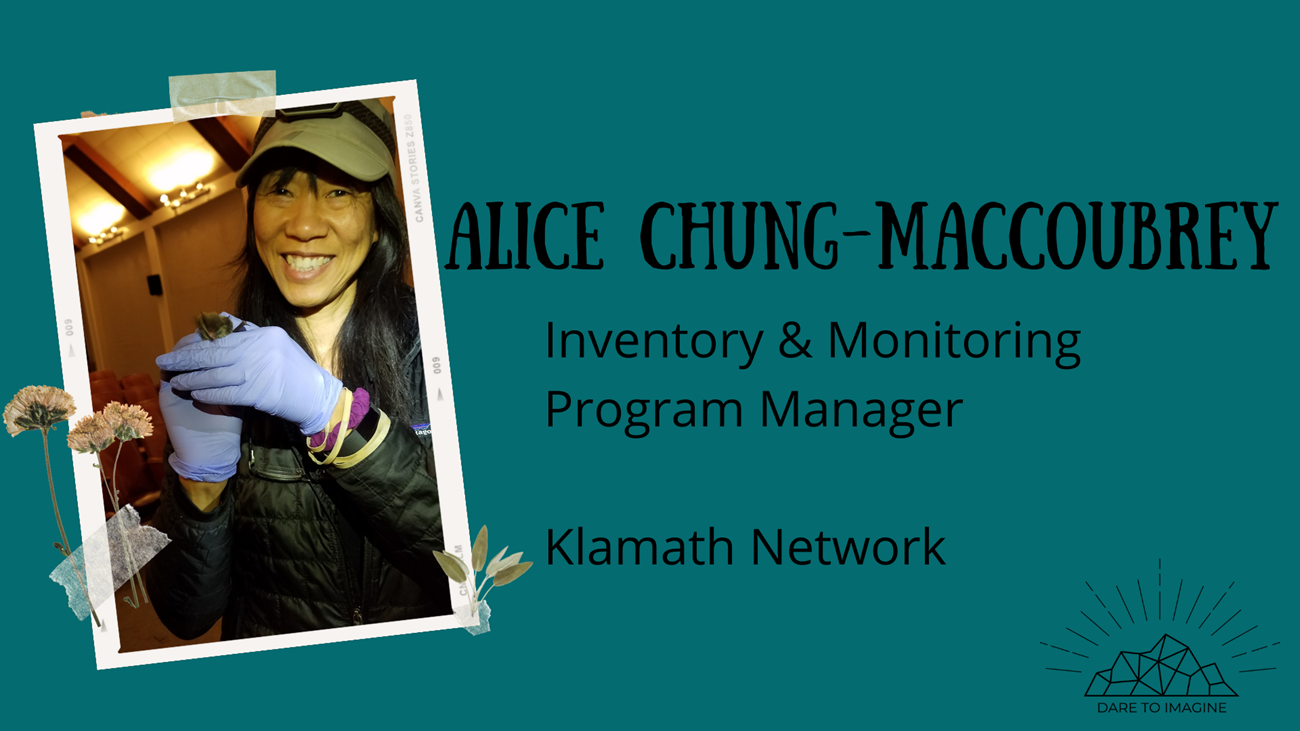Last updated: November 15, 2021
Article
Dare to Imagine: Alice Chung-MacCoubrey

Women Lifting Other Women
She is passionate about bats and dedicated to protecting them from white-nose syndrome as it spreads in the West. She gets funding, she works with multi-agency collaborations, and she's experimenting with potential treatment of bats and caves to destroy the Pd fungus that causes white-nose syndrome. Her Klamath Network Inventory and Monitoring (KLMN) crew discovered the first evidence of white-nose syndrome in California last year. She is doing essential bat conservation work, all the while managing the KLMN I&M team to support conservation of natural resource "vital signs" in the network's parks.
Sonya Daw, Inventory and Monitoring Division Science Communication Specialist, Klamath Network I&M

Alice, what project would you like to highlight?
My primary duties are running the Inventory & Monitoring program for the Klamath Network of parks in Southern Oregon and Northern California. But I'd like to highlight ancillary work supporting parks in understanding the status of white nose syndrome (WNS), which is decimating bat populations nationwide, and research on potential treatment options and the roost ecology of bats.Will you tell us a little about the project?
I have 2 projects I would like to highlight in particular. One is wildlife disease surveillance. I train crews to capture and swab bats at their spring maternity roosts to detect the arrival of the disease white-nose symdrome (WNS) and the fungus Pd that causes it. Another project is to find where bats roost during the winter. My team captures bats in the fall, affixing radiotransmitters, and tracking them back to their roosts. This is important because we don't know where bats hibernate in the West.
How did you get to where you are now? What was your path like?
I had a strong interest in wildlife when I was young, but didn't know it could be a career. I'm from the suburbs of Philadelphia and first generation Chinese here in the US. I didn’t get much exposure to the outdoors and nature growing up. I explored my interest in wildlife while studying biochemistry at Rutgers University by volunteering on summer wildlife projects. In my senior year I took an elective course on forestry and wildlife conservation and was fascinated. But changing my degree would’ve delayed my graduation, so I finished my degree in biochemistry. Afterward, I volunteered on a whale research project in Maine, and then returned to work in a lab, where I felt uninspired. During a cross-Canada trip with my future husband, I gathered my courage to make a career change and return to school for wildlife studies. While taking classes, I got into a Cooperative Education Program with the US Forest Service, which eventually led to a research scientist position at the US Forest Service Rocky Mountain Research Station.
I studied bats in New Mexico for my PhD, and that's really where I found my passion. I’ve been working with bats on and off for the last 26 years. Later, I met some leaders in the National Park Service Inventory and Monitoring Program (I&M), and decided that's where I belonged. I joined the National Park Service as an I&M program manager at the Mojave Desert Network, then spent five wonderful years at Sierra Nevada Network, and finally came to the Klamath Network. I’ve been so incredibly privileged to have worked for so many amazing networks and parks!
What was the hardest part about getting where you are? How did you overcome it?
The hardest part of my journey was figuring out what I wanted to do and where I belonged... for my career. I had a few course corrections along the way. It was a trial and error process, but the common theme in my approach was to identify what skills or qualities the job needed, contemplate whether I had them, and if not, work to acquire them, even if the pursuit put me outside my comfort zone.
What are you most proud of?
I am proud of the fact that my family... my parents... supported my pursuit of a non-traditional career path for an Asian American. While I started off on a traditional trajectory (biochemistry), they supported my choice to follow my heart into a career in wildlife biology. As it pertains to what I'm proud of doing myself, I feel both proud and privileged to lead a program whose mission is to preserve and protect the amazing natural resources within our NPS parks for the public and for our planet. At a smaller scale, I love that I've been able to help other people share my appreciation of bats and how amazing and important they are. When I've given evening presentations on bats at parks, and been able to show people a live bat up close, or helped them listen to a bat flying overhead, it's really rewarding!Favorite Quote?

